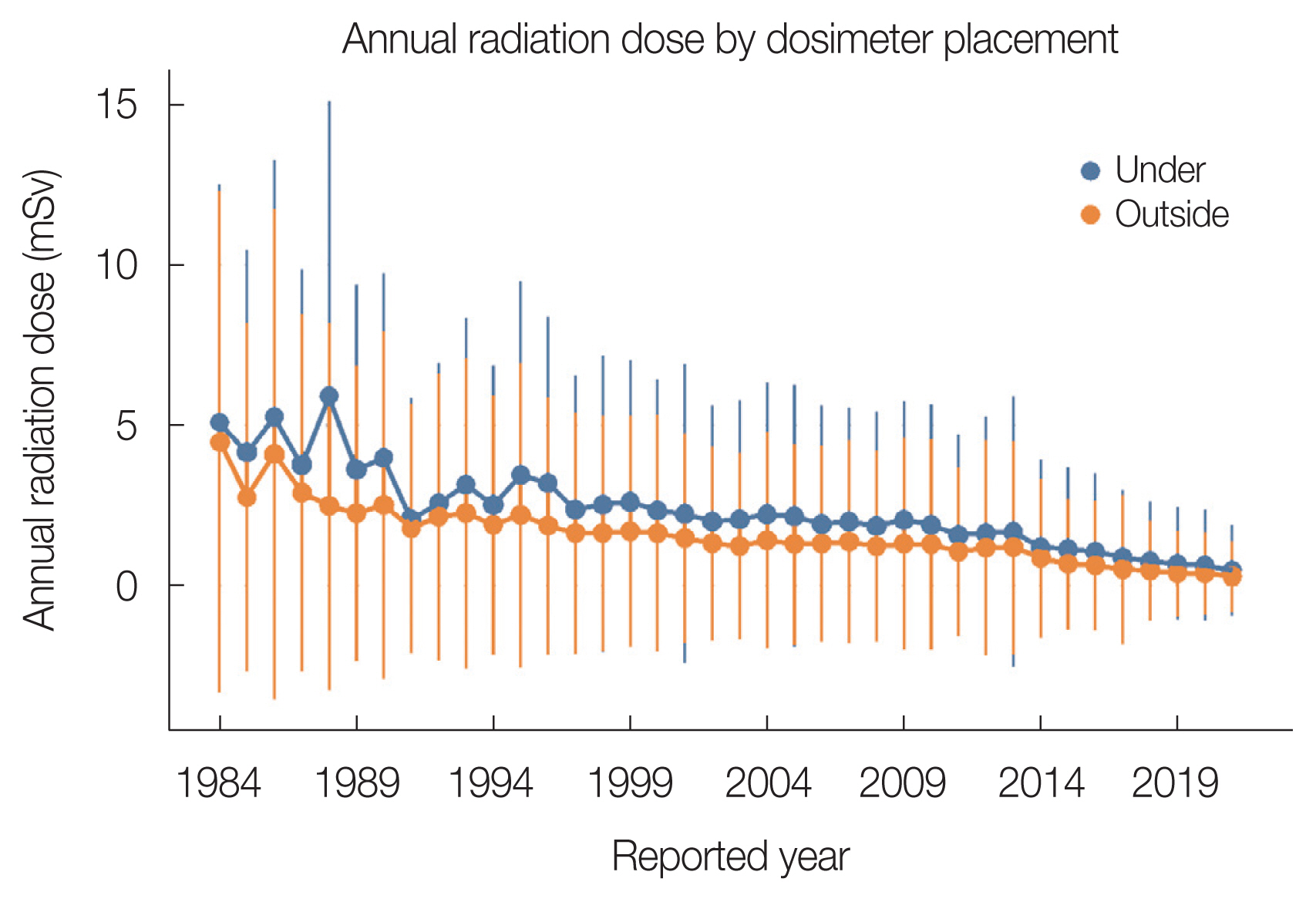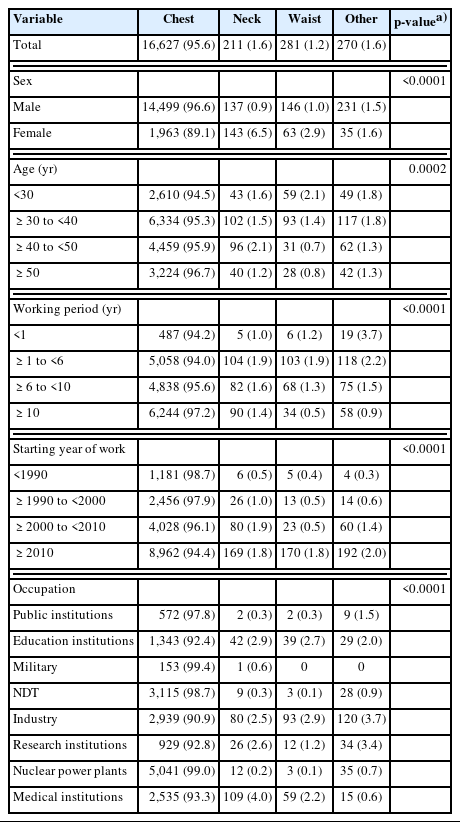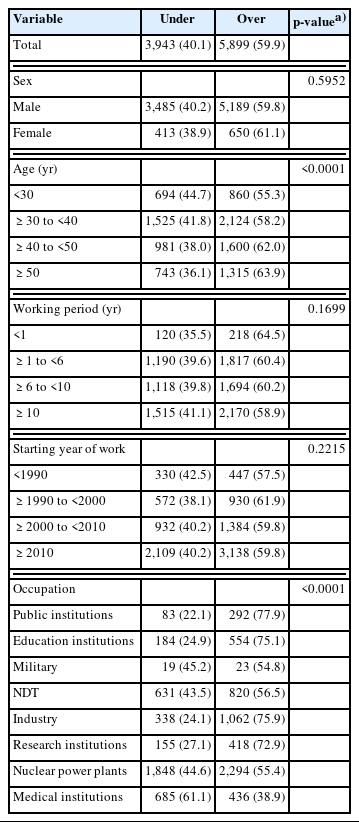Personal Dosimeters Worn by Radiation Workers in Korea: Actual Condition and Consideration of Their Proper Application for Radiation Protection
Article information
Abstract
Background
Assessment of the radiation doses to which workers are exposed can differ depending on the placement of dosimeters on the body. In addition, it is affected by whether the placement is under or over a shielding apron. This study aimed to evaluate the actual positioning of personal dosimeters on the body, with or without shielding aprons, among radiation workers in Korea.
Materials and Methods
We analyzed the survey data, which included demographic characteristics, such as sex, age, occupation, work history, and placement of the personal dosimeter being worn, from a cohort study of Korean radiation workers. We assessed the use of personal dosimeters among workers, stratified by sex, age, working period, starting year of work, and occupation.
Results and Discussion
Overall, high compliance (89.1% to 99.0%) with the wearing of dosimeters on the chest was observed regardless of workers’ characteristics, such as age, sex, occupation, and work history. However, the placement of dosimeters, either under or over the shielding aprons, was inconsistent. Overall, 40.1% of workers wore dosimeters under their aprons, while the others wore dosimeters over their aprons. This inconsistency indicates that radiation doses are possibly measured differently under the same exposure conditions solely owing to variations in the placement of worn dosimeters.
Conclusion
Although a lack of uniformity in dosimeter placement when wearing a shielding apron may not cause serious harm in radiation dose management for workers, the development of detailed guidelines for dosimeter placement may improve the accuracy of dose assessment.
Introduction
Radiation workers are exposed to varying levels of radiation during their work-related tasks. The wearing of a personal dosimeter is a recommended and conventional method for radiation protection and assessment of radiation doses in workplaces owing to its wearability and continuity in monitoring occupational exposure [1]. However, the radiation dose can differ according to the placement of the dosimeter. For example, it is affected by the dosimeter’s placement on the body of the radiation worker, e.g., under or over a shielding apron [2].
In Korea, radiation workers (mostly in radioactive isotope-related occupations) and diagnostic medical radiation workers (mostly in radiation generator [X-ray]-related occupations) must wear a personal dosimeter on their chest while at work, as specified by regulations under the Nuclear Safety Act [3] and the mandatory manual issued by the Korea Centers for Disease Control and Prevention, respectively [4]. However, for radiation workers who wear shielding aprons, the placement of dosimeters is not standardized. For example, diagnostic medical radiation workers are required to wear thermoluminescent dosimeter badges under the apron on the left side of the chest according to the mandatory manual [4]. Conversely, for other radiation workers, such as those working in nuclear power plants, industry, and research institutes, information on the placement of dosimeters when they wear shielding aprons is not sufficient in the guidelines for radiation protection in workplaces, although some major businesses and institutions have their own manuals which state that a dosimeter should be worn under a lead apron [5].
Therefore, this study aimed to examine how radiation workers in Korea wear their personal dosimeters with and without shielding aprons and to provide useful information for guidelines on dosimeter placement.
Materials and Methods
We examined survey data from a cohort study of Korean radiation workers [6] to determine where they placed their personal dosimeters. The data included demographic characteristics, such as sex, age, occupation, work history, and where they placed the dosimeter while working. Of the 20,608 radiation workers in the cohort, we analyzed data from 17,389 individuals who completed the questionnaire regarding the use of dosimeters.
We assessed the placement of personal dosimeters used by workers stratified by sex, age, working period, starting year of work, and occupation. Occupations were divided into eight categories: medical institutions, industries, non-destructive testing industries, research institutes, educational institutions, public institutions, nuclear power plants, and military institutions. In order to compare the distributions of the placement of dosimeters among workers with different demographic and occupational characteristics, a chi-square test was performed with a statistical significance level of 0.05. Owing to the exploratory nature of these analyses, multiplicity adjustments were not made. Data were analyzed using R version 4.0.5 (R Foundation for Statistical Computing).
Results and Discussion
Table 1 summarizes the distribution of personal dosimeter locations on the bodies of radiation workers. In total, 95.6% of radiation workers wore dosimeters on their chests. While women, younger workers, those with less work experience, and those in industry occupations were less likely to wear a dosimeter on their chest, the overall compliance rate was high (89.1% to 99.0%).
Table 2 summarizes the distribution of personal dosimeter positions for workers who wore shielding aprons. Of the 17,389 workers, 9,842 (56.6%) reported wearing a shielding apron. The placement of dosimeters varied among workers, with some wearing them under their shielding aprons and others wearing them over their aprons. Specifically, 40.1% of workers wore their dosimeters under their aprons. This inconsistency remained regardless of sex, age, working period, starting year of work, and type of occupation. Additionally, significant differences in these distributions were noted for age and occupation, as shown in Table 2.
Our study assessed the placement of personal dosimeters on the bodies of radiation workers in Korea. Overall, high levels of compliance with the wearing of dosimeters on the chest were observed regardless of workers’ characteristics, such as age, sex, occupation, and work history. This compliance indicates that the wearing of a dosimeter is well managed under the current regulations (regulations on evaluating and managing radiation exposure to individuals) in Korea [3].
Standard global practice is for workers to wear a single dosimeter on their chest (generally when not wearing a shielding apron). In Europe, the European Commission recommends wearing a dosimeter on the waist or chest [7]. In the United States, the National Council on Radiation Protection (NCRP) recommends placing a single dosimeter at the center of the chest, except when a beam is traveling from back to front [2]. These guidelines are based on the principle that the chest should be prioritized for protection as it is close to the heart [8].
The position of personal dosimeters, whether under or over the shielding apron, was inconsistent in this study, regardless of sex, age, working period, starting year of work, and occupation. This was mainly due to a lack of guidelines on dosimeter placement while wearing shielding aprons. The correct placement of dosimeters when shielding aprons are worn is particularly important for professionals in the medical diagnostic radiation field, such as interventional radiologists and cardiologists, who work closely with radiological sources [9]. In our study of radiation workers, except for medical diagnostic radiation workers, the radiation dose measured over the shielding aprons was not much different from that measured under the aprons, which indicates that workers wearing their dosimeters over their shielding aprons were working in an environment where they were less likely to be exposed to high radiation doses (e.g., working a long distance from radiation sources or in a shielded room) (Fig. 1). Nonetheless, although this lack of uniformity in dosimeter placement may not cause underestimation of radiation doses and seriously fallacious measurements in terms of radiation protection (e.g., management of radiation doses), it may result in different measurements of radiation doses under the same exposure conditions solely owing to variations in dosimeter positioning.

Annual radiation dose by dosimeter placement when wearing a shielding apron (mean doses and 95% confidence intervals).
The placement and quantity of personal dosimeters worn while using a shielding apron varies by country. In the United Kingdom and Eastern Europe, the dosimeter is recommended to be worn under the apron [10, 11]. This practice is in line with the International Commission on Radiological Protection's recommendations, which state that a single dosimeter worn under a lead apron can provide a reasonable estimate of the effective dose [12] and measure the dose to which protected organs are exposed [10]. However, recent studies have shown that the wearing of a single dosimeter under an apron can result in the underestimation of radiation doses [13]. Additionally, ensuring dosimeter compliance may be challenging, as a dosimeter worn under an apron is not visible to other staff and can be incorrectly positioned or not worn at all, as highlighted by Martin [10].
For this reason, various national and international organizations suggest using a two-dosimeter method. This involves wearing a primary dosimeter under a lead apron and an additional dosimeter at the collar level above the apron. In Japan, the Ministry of Health, Labour and Welfare recommends the placement of dosimeters under the lead apron on the chest for men and nonpregnant women, and on the waist for pregnant women or women with the potential for pregnancy, when a photon energy is uniform. When a photon energy is nonuniform, the use of two dosimeters is recommended, one under the apron on the chest or abdomen and the other over the apron at the neck [14]. The NCRP in the United States recommends the wearing of dosimeters on the chest for both pregnant and nonpregnant individuals and follows the same recommendations as Japan for nonuniform photon energy [2]. In Europe, two dosimeters are recommended to be worn in the same positions as those used in Japan when wearing an apron [7]. This approach could be more accurate for dose assessment because the two-dosimeter method provides a better approximation of the whole-body dose when readings are combined [2].
Conclusion
Placement of personal dosimeters for radiation workers is important for radiation protection and accurate assessment of radiation doses. While overall compliance with the wearing of dosimeters is desirable, their positions when wearing a shielding apron have not been consistent. Although this lack of uniformity may not cause serious fallacy in radiation dose management for radiation protection, the development of detailed guidelines for dosimeter placement with consideration of the wearing of shielding gears, such as aprons and vests, may improve the accuracy of dose assessment.
Notes
Conflict of Interest
No potential conflict of interest relevant to this article was reported.
Ethical Statement
This study was approved by the Institutional Review Board (IRB) of the Korea Institute of Radiological and Medical Sciences (IRB No. KIRAMS-2021-03-004). Written informed consent was obtained from all study participants.
Author Contribution
Conceptualization: Seo S. Methodology: Noh E. Data curation: Noh E, Lee D, Seo S. Supervision: Seo S. Funding acquisition: Park S. Writing - original draft: Noh E. Writing - review and editing: Seo S. Approval of final manuscript: all authors.
Acknowledgements
This work was supported by the Korea Institute of Radiological and Medical Sciences, funded by the Nuclear Safety and Security Commission, Republic of Korea (50091).


